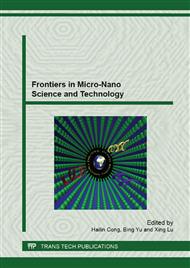[1]
Fanghua Zhang, Jianjun Ni, and Yijie Yu. High Power Factor AC–DC LED Driver With Film Capacitors. IEEE Transactions on Power Electronics. 2013, 38: 4831-4880.
DOI: 10.1109/tpel.2012.2233498
Google Scholar
[2]
Y. -C. Li and C. -L. Chen, A novel single-stage high-power-factor AC-to-DC LED Driving circuit with leakage inductance energy recycling, IEEE Trans. Ind. Electron., 2012, 59: 793–802.
DOI: 10.1109/tie.2011.2151817
Google Scholar
[3]
Junli Zhou, LinYu, MingSun, FeiYe, et al. Well-ordered organic-inorganic hybrid layered manganese oxide nanocomposites with excellent decolorization performance. Journal of Solid State Chemisity. 2013, 198: 371-378.
DOI: 10.1016/j.jssc.2012.10.030
Google Scholar
[4]
Selliner A, Weiss PM, Nguyen A, et al. Continuous self-assembly organic-inorganic nanocomposite coatings that mimicnacre. Nature. 1998, 349: 256 -260.
Google Scholar
[5]
Inagaki S, Guan S, Ohsuna T, et al. An ordered mesoporous organosilica hybrid material with a crystal-like wall structure. Nature. 2002, 416: 304-307.
DOI: 10.1038/416304a
Google Scholar
[6]
Junli Zhou, LinYu n, MingSun, FeiYe, et al. Organic-inorganic hybrid network constructed in polypropylene matrix and its reinforcing effects on polypropylene composites. Journal of Reinforced Plastics and Composites. 2013, 32( 3): 174-182.
DOI: 10.1177/0731684412467841
Google Scholar
[7]
Sayari A, Hamoudi S. Periodic mesoporous silica-based organic-inorganic nanocomposite materials. Chem. Mater. 2001, 13: 3151-3168.
DOI: 10.1021/cm011039l
Google Scholar
[8]
Park Y, Nagai M. Proton exchange nanocomposite membranes based on 3-glycidoxypropyltrimethoxysilane silicotungstic acid and a -zirconium phosphate hydrate. Solid State Ionics. 2001, 145: 149-160.
DOI: 10.1016/s0167-2738(01)00925-0
Google Scholar
[9]
Roya Ravarian, Hua Wei, Aditya Rawal, et al. Molecular interactions in coupled PMMA-bioglass hybrid networks. J. Mater. Chem. B, 2013, 1, 1835-1845.
DOI: 10.1039/c2tb00251e
Google Scholar
[10]
Ishii Ryo, Naganawa Ryuichi, et al. Microporous Organic-inorganic Nanocomposites as the Receptor in the QCM Sensing of Toluene Vapors. Analytical Sciences. 2013, 29(3), 283-289.
DOI: 10.2116/analsci.29.283
Google Scholar
[11]
Cottineau Thomas, Richard-Plouet Mireille, Mevellec, et al. Hydrolysis and Complexation of N, N-Dimethylformamide in New Nanostructurated Titanium Oxide Hybrid Organic-Inorganic Sols and Gel . Journal of Physical Chemistry. 2011, 115(25) : 12269-12274.
DOI: 10.1021/jp201864g
Google Scholar
[12]
Lee Kwang H, Park Chan Ho, et al. Semi-transparent organic/inorganic hybrid photo-detector using pentacene/ZnO diode connected to pentacene transistor. Organic Electeronics. 2011, 12(7): 1103-1107.
DOI: 10.1016/j.orgel.2011.03.025
Google Scholar
[13]
French R.H., Glass S.J., Ohuchi F.S. Experimental and theoretical determination of the electronic structure and optical properties of three Phases of ZrO2, Phys. Rev. B. 1994(49): 5133-5138.
Google Scholar


